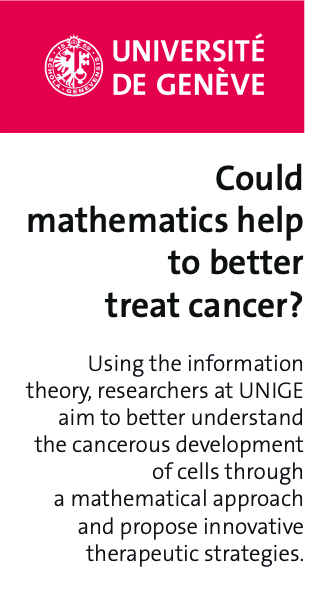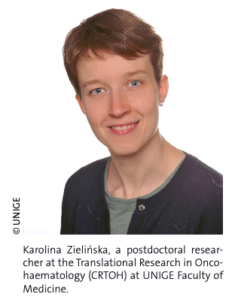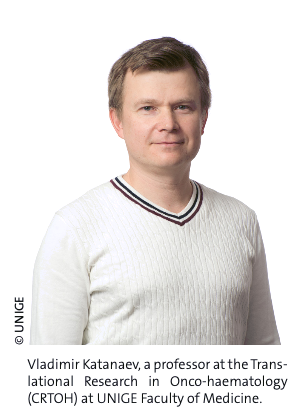
Using the information theory, researchers at UNIGE aim to better understand the cancerous development of cells through a mathematical approach and propose innovative therapeutic strategies.
The development and survival of living beings are linked to the ability of their cells to perceive and respond correctly to their environment. To do this, cells communicate through chemical signal systems, called signalling pathways, which regulate and coordinate cellular activity. However, impaired information processing may prevent cells from perceiving their environment correctly; they then start acting in an uncontrolled way and this can lead to the development of cancer. To better understand how impaired information transmission influences the activity of diseased cells, researchers at the University of Geneva (UNIGE), Switzerland, are going beyond the field of biology. They propose to examine cellular communication in the light of information theory, a mathematical theory more commonly used in computer science. This work, to be discovered in the journal Trends in Cell Biology, offers a radically new approach to oncology.
“In a way, cancer can be viewed as an information disease”,
says Karolina Zielińska, a researcher at the Translational Research in Onco-haematology (CRTOH) at UNIGE Faculty of Medicine and first author of this work.
“But while the oncogenic power of over- or under-activated signalling pathways is becoming well known, the exact mechanisms remain quite mysterious.” How, indeed, do cells make their decisions based on the information they perceive – or no longer perceive? “Sometimes biology alone is not enough to decipher everything”,
explains Vladimir Katanaev, a professor at CRTOH, who led the research.
Measuring uncertainty
In the late 1940s, American mathematician Claude Shannon developed a probabilistic theory to quantify the information transmitted in a set of messages over a noisy communication channel. This theory has enabled the development of modern communication systems and computers. It is also the basis for a multitude of applications such as data compression and transmission, cryptography and artificial intelligence.
“But curiously, Shannon’s theory has not much been applied in the field of cell signalling”, says Karolina Zielińska, who is both a mathematician and a biologist. “Our idea is to use this powerful tool to examine the decisions made by diseased cells and compare them to those made by healthy cells.”
 Information theory uses probability theory as a fundamental tool. Its main concept, called entropy, aims to measure the uncertainty of random variables. “If, for example, we flip a coin, the coin may randomly fall on heads or tails, so the result is uncertain. Now imagine a coin with two identical faces: the result is certain, and the entropy is nil. Entropy thus evaluates the degree of uncertainty of a random variable. When applied to communication, entropy indicates the amount of information necessary for the receiver to determine unambiguously what the source has transmitted.”
Information theory uses probability theory as a fundamental tool. Its main concept, called entropy, aims to measure the uncertainty of random variables. “If, for example, we flip a coin, the coin may randomly fall on heads or tails, so the result is uncertain. Now imagine a coin with two identical faces: the result is certain, and the entropy is nil. Entropy thus evaluates the degree of uncertainty of a random variable. When applied to communication, entropy indicates the amount of information necessary for the receiver to determine unambiguously what the source has transmitted.”
From mathematics to biology
Applied to cell signalling, information theory allows studying how cells process the information they receive from their environment. When a cell receives a stimulus – an information – from its environment, what concentrations of information can the cell process without error? Knowing a cell response, can we distinguish between different stimuli to evaluate which one triggered this particular response? These questions are essential in the field of cancer. Indeed, cancer cells may be unable to process information from the environment as well as healthy cells, and start to proliferate and divide when it is not necessary to do so.
 Researchers will now test the validity of their approach by studying how breast and lung cancer cells process information from their environment. Indeed, current treatments generally aim to remove or completely extinguish certain signalling pathways, despite significant side effects. “The new approach we are proposing is not aimed at shutting down the signalling pathways, but rather at restoring their proper activity”, says Vladimir Katanaev. “By applying pure mathematical concepts to biology, we hope to identify information transmission failures that need to be fixed to correct them.”
Researchers will now test the validity of their approach by studying how breast and lung cancer cells process information from their environment. Indeed, current treatments generally aim to remove or completely extinguish certain signalling pathways, despite significant side effects. “The new approach we are proposing is not aimed at shutting down the signalling pathways, but rather at restoring their proper activity”, says Vladimir Katanaev. “By applying pure mathematical concepts to biology, we hope to identify information transmission failures that need to be fixed to correct them.”
CRTOH is part of the Swiss Cancer Center Léman (SCCL), a multidisciplinary alliance bringing together the UNIGE, HUG, EPFL, CHUV, UNIL and the ISREC Foundation to conduct fundamental, translational and clinical research in the field of cancer.
This research is published in
Trends in Cell Biology
DOI: 10.1016/j.tcb.2019.08.005
Karolina Zielińska
Postdoctoral Researcher
Department of Cell Physiology and Metabolism & Translational Research Centre in Onco-haematology Faculty of Medicine
Vladimir Katanaev
Full Professor
Department of Cell Physiology and Metabolism & Translational Research Centre in Onco-haematology Faculty of Medicine
Image: Courtesy of UNIGE
Source: Université de Genève UNIGE, Oct 29, 2019
https://www.unige.ch/
Claude Shannon – The Bit Player Movie Trailer
Trailer for a new film by Mark Levinson (Particle Fever) about Claude Shannon, the “Father of Information Theory,” whose ideas influence such diverse fields as communication, linguistics, genetics, computing, cryptography, neuroscience, artificial intelligence and cosmology.
Source: The Bit Player // Youtube 16.05.2019
youtu.be/E3OldEtfBrE
What is entropy? – Jeff Phillips
There’s a concept that’s crucial to chemistry and physics. It helps explain why physical processes go one way and not the other: why ice melts, why cream spreads in coffee, why air leaks out of a punctured tire. It’s entropy, and it’s notoriously difficult to wrap our heads around. Jeff Phillips gives a crash course on entropy.
Lesson by Jeff Phillips, animation by Provincia Studio.
Source: YouTube 5:19 min // 9. Mai 2017
youtu.be/YM-uykVfq_E
